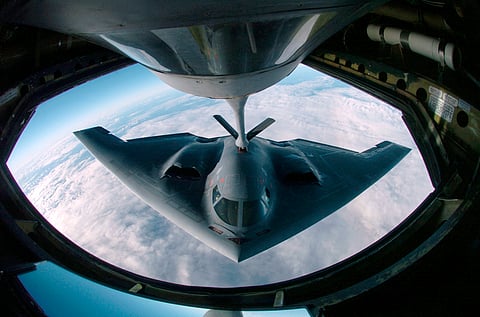Iran-Israel conflict: How B-2 bombers flew 37 hours non-stop to hit deep inside Iran’s nuclear sites
Mid-air refuelled, radar-proof, bunker-loaded — the US strike Iran never saw coming

Dubai: In one of the most dramatic escalations in US-Iranian tensions in decades, American B-2 Spirit stealth bombers flew non-stop for nearly 37 hours from Whiteman Air Force Base in Missouri to strike three of Iran’s most fortified nuclear sites early Sunday, delivering what President Donald Trump called a “very successful attack” on Tehran’s atomic programme.
According to The New York Times, the mission required multiple mid-air refuelling operations, with the B-2 bombers flying deep into hostile airspace to unleash six GBU-57 “bunker buster” bombs on Iran’s Fordow facility — a site long regarded as impenetrable due to its deep underground construction inside a mountain.
“Fordow is gone,” Trump declared on Truth Social, calling the operation an “amazing success.” He warned that Iran must “make peace immediately or they’ll get hit again.”
What's Midnight Hammer?
In the first public accounting of the operation, the Pentagon said the US strikes that targeted Iran’s nuclear sites involved submarines launching Tomahawk missiles and B-2 bombers dropping 14 bunker-buster bombs,
The operation — dubbed “Midnight Hammer” — saw the US deploy B-2 stealth bombers from Whiteman Air Force Base in Missouri, Air Force General Dan Caine, the chairman of the Joint Chiefs of Staff, told reporters at a press conference Sunday morning. He said there are no reports of US forces coming under fire.
According to Caine, B-2 bombers took off early Saturday US time and later dropped the bunker busters, or the Massive Ordnance Penetrator bomb, which had never before been used in combat. Another group of the planes went west — and whose flight was widely reported and picked up by flight-tracker data — were decoys meant to maintain tactical surprise, he said.
Which weapons were used?
“This is a plan that took months and weeks of positioning and preparation, so that we could be ready when the President of the United States called,” Defence Secretary Pete Hegseth said.
“It took a great deal of precision. It involved misdirection and the highest of operational security.”
The officials said 75 precision-guided weapons were used and the operation involved some 125 aircraft. Caine said the battle damage would take time to assess but “all three sites sustain extremely severe damage and destruction.”
The flights to deliver the targets amounted to the second-longest flights in the B-2’s operational history, according to Hegseth. The longest was a 40-hour round trip in October 2001 in the initial phase of the Afghanistan war.
What are B-2 bombers?
The B-2 Spirit is one of the most secretive and lethal aircraft ever built. Manufactured by Northrop Grumman, the bomber is famed for its stealth technology, which enables it to bypass even the most sophisticated air defense systems. Flying virtually undetected, it can deliver over 40,000 pounds of payload and has a global reach thanks to aerial refuelling.
Specifically built for missions like this, the B-2 is capable of deploying the GBU-57A/B Massive Ordnance Penetrator — a 30,000-pound precision-guided bomb designed to destroy deeply buried bunkers. The Fordow strike demonstrated why the B-2 remains unmatched in its ability to silently hit hardened targets deep inside enemy territory.
Fordow, Natanz and Esfahan targeted
Alongside the strike on Fordow, American submarines stationed roughly 400 miles away in the Gulf launched 30 Tomahawk cruise missiles at Natanz and Esfahan, other key nuclear development sites. The missiles — known for their long-range, low-altitude precision — hit infrastructure believed to be linked to uranium enrichment and missile development.
“Only the US military has the capability to destroy a site like Fordow,” said a Western defense analyst. “Israel’s strikes severely damaged Natanz and Isfahan, but they couldn’t reach Fordow. That’s why the B-2 and the bunker busters had to be used.”
Iran warns of ‘irreparable damage’
Iran’s Supreme Leader Ayatollah Ali Khamenei issued a grave warning, saying the US had inflicted “irreparable damage” and would be met with severe consequences. Iran’s nuclear regulatory agency claimed there was no radiation leakage, but confirmed damage to parts of Fordow, according to state-linked Tasnim News Agency.
The Pentagon said all American aircraft returned safely, but officials acknowledged the risk of reprisal. With over 50,000 US troops stationed across the Middle East, military readiness levels have been raised, especially in Iraq, Kuwait, and Bahrain, where American bases may become targets for Iranian retaliation.
Israel, which claims Iran is “weeks away” from a nuclear weapon, coordinated closely with Washington. Prime Minister Benjamin Netanyahu reportedly spoke to Trump immediately after the mission.
“Our American allies did what we could not. Fordow is no longer a threat,” an Israeli intelligence official told local media.
Will this spark a wider war?
The coordinated assault on Iran’s nuclear infrastructure could have cascading consequences. Oil prices are expected to surge, with fears of attacks on Gulf shipping lanes. Iran’s regional proxy networks — from Hezbollah in Lebanon to militia groups in Iraq and Syria — could retaliate in kind.
While Trump framed the attack as a deterrent — stating “Now is the time for peace” — analysts warn that the operation may trigger a new phase of open confrontation in the Middle East, pitting Iran against a US-Israel military axis.
"This wasn't just a strike on a nuclear facility," said a former CIA officer. "It was a message. The question now is — how will Iran respond?"
Sign up for the Daily Briefing
Get the latest news and updates straight to your inbox




